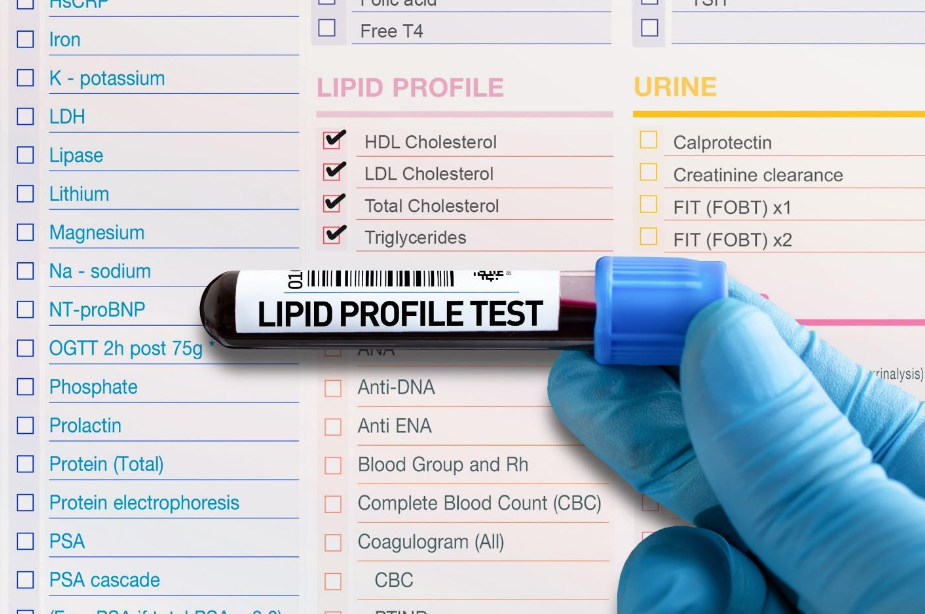Your Guide to Cholesterol Testing
Your Guide to Cholesterol Testing

Does the word “cholesterol” have you upset or worried in any way? You’re not alone. With high cholesterol causing 4.4 million deaths per year, it is only natural that being prescribed a cholesterol test would leave you anxious.
However, there’s a lot to know before assuming the worst. For starters, cholesterol is naturally occurring in the human body. This soft, wax-like substance produced by the liver is actually required for day-to-day tasks like digesting fatty foods, developing healthy cells, or producing hormones!
In short, cholesterol is not all that bad. But like everything, too much of anything can make you sick, and that’s where the negative publicity of cholesterol takes centerstage. Keep reading to take a detailed look at cholesterol testing—starting with what it is to what comes next.
What Is a Cholesterol Test?
A cholesterol test or lipid profile is used to measure the concentration and distribution of fats, namely cholesterol and triglycerides, in the blood. Typically, it will monitor the following values:
- Total Cholesterol Levels: This is the total amount of cholesterol present in a person’s blood.
- Low-density lipoprotein (LDL) cholesterol: It is the “bad cholesterol” that has an oxidative effect and causes plaque buildup that clogs your arteries. High LDL levels can lead to heart attacks, strokes, etc.
- Very-low-density lipoprotein (VLDL) cholesterol: It is a type of LDL containing the highest number of triglycerides, which means that it also counts as “bad cholesterol.”
- High-density lipoprotein (HDL) cholesterol: It is the “good cholesterol” that binds with LDL to neutralize its effect and maintain cardiovascular health.
- Non-HDL: This is the difference between the total cholesterol levels and HDL cholesterol levels. It typically comprises LDL, VLDL, and triglycerides.
- Triglycerides: These are fat deposits in the bloodstream, which are broken down by the body to generate energy.
Why Should You Get a Cholesterol Test?
Lipid tests grant an overview of the different types of fats and their respective concentration. As such, it can be used as an assessment tool to calculate cardiovascular risks before they actually occur. Doctors use cholesterol tests to measure and analyze the fats present in the blood. Based on the results, they may recommend certain interventional treatments to maintain cholesterol to healthy levels.
On the other hand, if left untreated, high cholesterol levels can accumulate on arterial walls to form a hardened surface called plaque. This deposition causes the arteries to constrict, thereby obstructing the flow of blood to the heart, which can lead to a heart attack.
Who Should Get a Cholesterol Test?
According to the CDC, children, and adolescents should get their cholesterol levels checked at least once between ages 9 to 11 and 17 to 21. At the same time, adults should get their cholesterol levels tested every 4-6 years. People who are 65+ should undergo annual cholesterol tests.
More frequent cholesterol testing may be necessary for the following groups:
- Those having a family history of cardiovascular diseases, high cholesterol, and diabetes.
- People with diabetes.
- Those who are physically inactive.
- Overweight individuals.
- Those who consume an unhealthy diet.
- Smokers.
What are Ideal Cholesterol Levels?
Cholesterol levels are measured in milligrams per deciliter (mg/dL). The healthy range varies on the basis of the individual’s age and gender. The typical benchmarks are as follows:
Anyone less than or equal to 19 years of age:
Type of Cholesterol & Healthy Levels
- Total Cholesterol
- < 170 mg/dL
- LDL
- < 100 mg/dL
- HDL
- > 45 mg/dL
- Non-HDL
- < 120 mg/dL
People assigned male at birth, aged 20 and above:
Type of Cholesterol & Healthy Levels
- Total Cholesterol
- 125 mg/dL to 200 mg/dL
- LDL
- < 100 mg/dL
- HDL
- > 40 mg/dL
- Non-HDL
- < 130 mg/dL
People assigned female at birth, aged 20 and above:
Type of Cholesterol & Healthy Levels
- Total Cholesterol
- 125 mg/dL to 200 mg/dL
- LDL
- < 100 mg/dL
- HDL
- > 50 mg/dL
- Non-HDL
- < 130 mg/dL
What Happens During a Cholesterol Test?
A cholesterol test is a simple procedure where the phlebotomist draws blood from your vein. Do note that it is recommended to fast 9-12 hours before the test, which is why they are generally scheduled in the mornings.
While performing the cholesterol test, the technician will first examine your arm to find a suitable spot and clean it with an antiseptic. Then, they will wrap a band around your arm and tighten it to make the vein pop out.
Finally, they will puncture the vein with a syringe and collect blood by releasing the band. Once the vial is full, they will remove the needle and apply a cotton swab at the puncture site to stop the bleeding. The blood sample will be transported to the lab for examination.
What are the Treatment Options for High Cholesterol?
Having borderline high or high cholesterol does not automatically mean that the individual is bound to have a stroke or a heart attack. In fact, the cholesterol test comes at the most opportune moment so that you or your caregiver can devise a strategy to lower cholesterol levels.
They may prescribe medicines, recommend lifestyle changes, or both. Some common lifestyle changes one needs to make to keep cholesterol in control are:
- Exercising regularly and increasing physical activity
- Maintaining healthy weight
- Quitting or cutting down on smoking
- Following a heart-healthy diet
- Keeping stress levels low
- Sleeping 7-9 hours
- Limiting alcohol consumption
As for the medication, you may be prescribed statins, PCSK9 inhibitors, bile acid sequestrants, etc., for those needing immediate attention or for the high-risk groups.
Foods That Lower Cholesterol
Diet plays a crucial role in cholesterol management. On that note, consider adding the following foods to your plate to lower LDL and boost HDL levels:
- Eggplant: 100g of raw eggplant contains 3g of fiber, making it a fiber-rich vegetable.
- Okra: Researchers discovered that mucilage, a lubricative gel found in okra, can lower cholesterol levels by binding to it.
- Apples: Apples contain 3 to 7g of dietary fiber along with polyphenols that neutralize LDL.
- Avocado: This fatty fruit contains 14.7g of monosaturated fats per 150g and can significantly reduce the chances of strokes and heart diseases.
- Fatty Fish: Fatty fish like herring, mackerel, tuna, salmon, sardines, and trout are a healthy source of Omega-3 fats, which supports heart health.
- Oats: A study found that the high fiber content of oats (3g per 100g of oatmeal) can reduce LDL cholesterol levels by an impressive 11.6% in just 28 days.
- Whole grains: Whole grains like barley are loaded with vitamins, minerals, and fiber that reduce LDL cholesterol.
- Nuts: Nuts like almonds, walnuts, cashews, pistachios, etc., are a good source of unsaturated fats, which can replace saturated fats.
- Soy and soy products: Soy and soy products like soy milk, tofu, and soy yogurt have a cholesterol-lowering effect of almost 3-4%.
- Dark chocolate: The flavonoids present in the cocoa of dark chocolates can lower cholesterol and regulate blood pressure. However, dark chocolate must be eaten in moderation.
- Lentils: Lentils are rich in fiber and can bring down LDL and triglyceride levels while increasing HDL levels.
- Garlic supplements: Garlic supplements can help control serum cholesterol levels and manage blood pressure more effectively.
- Green tea: Catechins, the antioxidant found abundantly in green tea, can improve your lipid profile by lowering LDL cholesterol as HDL levels remain unchanged.
- Extra virgin olive oil (EVOO): EVOO is an excellent substitute for unhealthy cooking oils that are loaded with LDL. Plus, its anti-inflammatory and antioxidant effects can improve overall health.
- Kale: It is an excellent source of soluble fiber, with a cup of boiled kale containing 4.7g of fiber. Plus, the antioxidants present in kale can oxidize LDL.
- Pumpkin: Pumpkin, when eaten along with the skin, can help lower the cholesterol levels in the blood. It is high in potassium, which might help prevent vascular calcification.
- Berries: Like apples, berries such as blackberries and strawberries are high in polyphenols and fiber, both of which help reduce the buildup of LDL cholesterol.
Foods That Can Increase Cholesterol
If you are looking to control high cholesterol levels, then you must avoid the following foods:
- Red meat, such as beef, lamb, and pork, contains high amounts of saturated fats.
- Deep-fried foods—from French fries to onion rings to mozzarella sticks—can increase your cholesterol levels (and weight).
- Processed and deli meat like bacon, sausage, hot dogs, etc., as they are highly processed and typically made from red meat.
- Junk food or fast-food items that are ultra-processed and packed with trans fats are extremely harmful to the heart and can elevate LDL.
- Baked, sugary goods like cakes, pastries, and cookies contain an unhealthy amount of saturated fats and are chock full of sugar.
Help is Right Here
A cholesterol test is a currency for cardiovascular health. Prepare a schedule and stick to it to monitor your cholesterol levels closely. If you are looking for technicians and lab experts who can perform cholesterol tests, then head over to the Rocky Vista Health Center for the highest level of patient care in all of Parker, CO. We offer an array of services to cover a majority of your medical and healthcare needs. Call us at (720) 875-2880 or schedule an appointment now!


We Are Accepting New Patients!
All Rights Reserved | Rocky Vista Health Center

